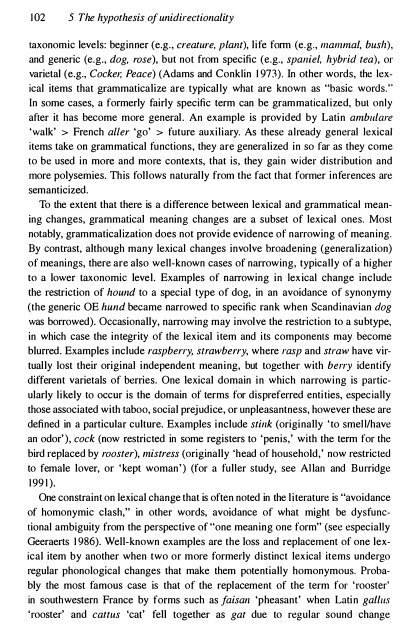Gram - SEAS
Gram - SEAS
Gram - SEAS
You also want an ePaper? Increase the reach of your titles
YUMPU automatically turns print PDFs into web optimized ePapers that Google loves.
102 5 The hypothesis of unidirectionality<br />
taxonomic levels: beginner (e.g., creature, plant), life form (e.g., mammal, bush),<br />
and generic (e.g., dog, rose), but not from specific (e.g., spaniel, hybrid tea), or<br />
varietal (e.g., Cocker, Peace) (Adams and Conklin 1973). In other words, the lexical<br />
items that grammaticalize are typically what are known as "basic words."<br />
In some cases, a formerly fairly specific term can be grammaticalized, but only<br />
after it has become more general. An example is provided by Latin ambulare<br />
'walk' > French aUer 'go' > future auxiliary. As these already general lexicaf<br />
items take on grammatical fu nctions, they are generalized in so far as they come<br />
to be used in more and more contexts, that is, they gain wider distribution and<br />
more polysemies. This follows naturally from the fact that former inferences are<br />
semanticized.<br />
To the extent that there is a difference between lexical and grammatical meaning<br />
changes, grammatical meaning changes are a subset of lexical ones. Most<br />
notably, grammaticalization does not provide evidence of narrowing of meaning.<br />
By contrast, although many lexical changes involve broadening (generalization)<br />
of meanings, there are also well-known cases of narrowing, typically of a higher<br />
to a lower taxonomic level. Examples of narrowing in lexical change include<br />
the restriction of hound to a special type of dog, in an avoidance of synonymy<br />
(the generic OE hund became narrowed to specific rank when Scandinavian dog<br />
was borrowed). Occasionally, narrowing may involve the restriction to a subtype,<br />
in which case the integrity of the lexical item and its components may become<br />
blurred. Examples include raspberry, strawberry, where rasp and straw have virtually<br />
lost their original independent meaning, but together with berry identify<br />
different varietals of berries. One lexical domain in which narrowing is particularly<br />
likely to occur is the domain of terms for dispreferred entities, especially<br />
those associated with taboo, social prejudice, or unpleasantness, however these are<br />
defined in a particular culture. Examples include stink (originally 'to smell/have<br />
an odor'), cock (now restricted in some registers to 'penis,' with the term for the<br />
bird replaced by rooster), mistress (originally 'head of household,' now restricted<br />
to female lover, or 'kept woman') (for a fuller study, see Allan and Burridge<br />
1991).<br />
One constraint on lexical change that is often noted in the literature is "avoidance<br />
of homonymic clash," in other words, avoidance of what might be dysfunctional<br />
ambiguity from the perspective of "one meaning one form" (see especially<br />
Geeraerts 1986). Well-known examples are the loss and replacement of one lexical<br />
item by another when two or more formerly distinct lexical items undergo<br />
regular phonological changes that make them potentially homonymous. Probably<br />
the most famous case is that of the replacement of the term for 'rooster'<br />
in southwestern France by forms such as fa isan 'pheasant' when Latin gallus<br />
'rooster' and cattus 'cat' fell together as gat due to regular sound change
















